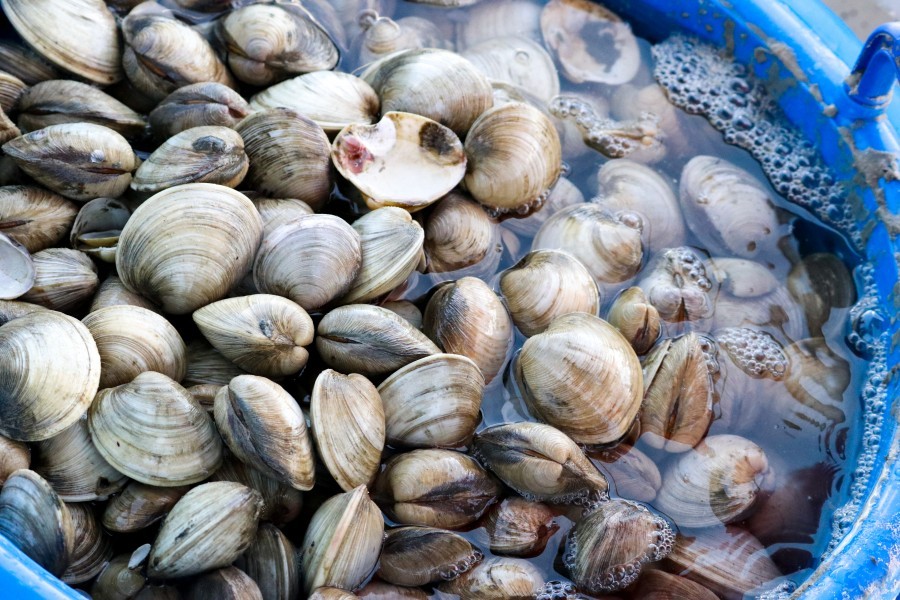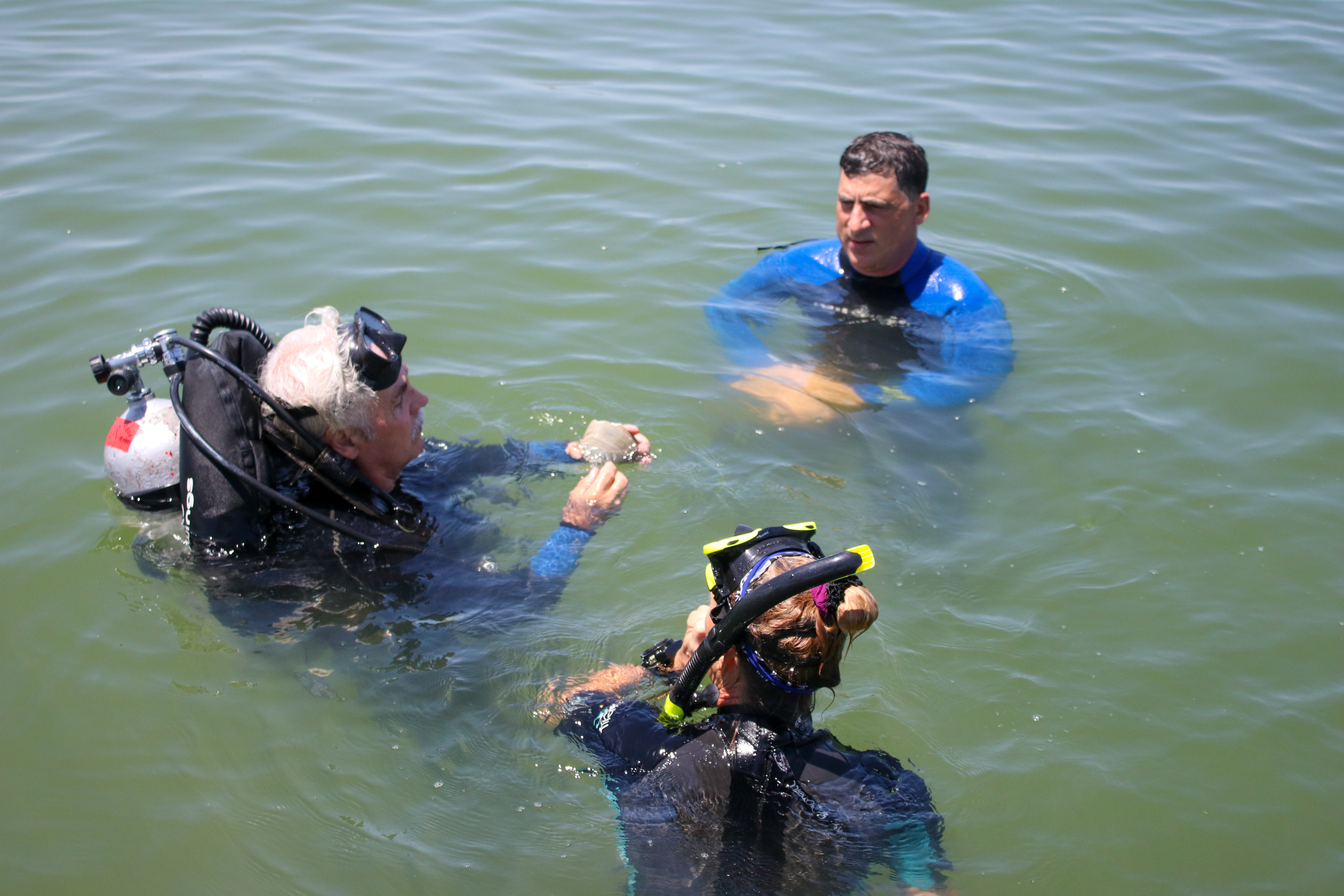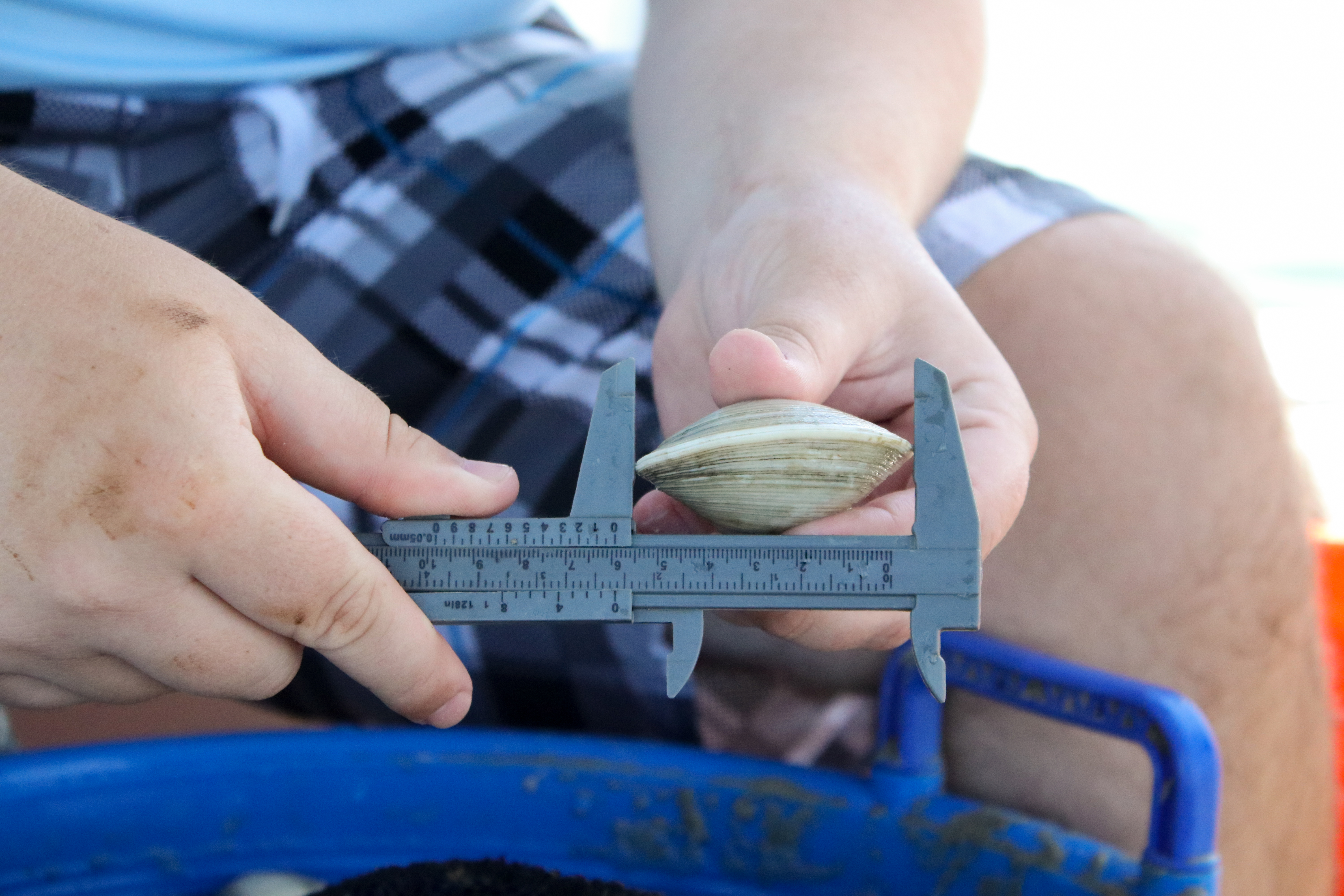Summer gets clammy: Shellfish restoration study under way

Southern hard clams ready for release by Sarasota Bay Watch and monitoring by Mote. Credit Madi O'Neill/Mote Marine Laboratory
End-of-year updates (December 2018)
- Between April 20 and Dec. 1, the nonprofit Sarasota Bay Watch and its volunteers released 177,000 young adult, native, southern hard clams (Mercenaria campechiensis) produced by Bay Shellfish Company and raised by commercial clam farmers, under Sarasota Bay Watch’s permit from the Florida Fish & Wildlife Conservation Commission. During multiple release events, Mote scientists placed or buried a subset of the clams in specific configurations and habitats for in-water studies on a wide range of parameters, such as growth rates, survivability, tolerance of Florida red tide (Karenia brevis) algal blooms, and predation by animals including whelks and spotted eagle rays.
- An important initial finding from the 2018 work is that the monitored clams were highly resistant to Florida red tide, surviving the extended exposure and the high, peak levels of red tide found in Sarasota Bay this year.
- After three months, survival was good in the restoration areas and long term study is ongoing, Mote scientists report. However, survival in shallow water areas could not be assessed due to vandalism of the marked study plots.
- Sarasota Bay Watch expects to release another 35,000 to 40,000 clams into Sarasota Bay during early 2019, and they have fine-tuned their transport process to minimize the clams’ time out of water and keep the clams at a more constant temperature. In addition, they’re at the beginning of their planning process for growing 500,000 to 1,000,000 native southern hard shell clams in phase 2 of their clam restoration program. Their clams are being grown past the normal size used for restaurants. Sarasota Bay Watch staff note that older and larger clams are more robust and more likely to spawn, and thereby help re-establish stable, reproducing populations.
- Mote will continue monitoring a portion of the clams put into different areas to evaluate survival.
Original story
Conservationists are ramping up clam-restoration efforts now in Sarasota Bay, Florida — locally the first of their kind — in partnership with Mote Marine Laboratory scientists who study how to fine-tune shellfish restoration methods to benefit the Bay.
The nonprofit Sarasota Bay Watch and its volunteers have begun purchasing and releasing native southern hard clams (Mercenaria campechiensis) produced by Bay Shellfish Company and raised by local commercial clam farmers. Under their permit from the Florida Fish & Wildlife Conservation Commission (FWC), Sarasota Bay Watch will have released about 125,000 clams by June 16, and more releases are planned to reach their total summer goal of 250,000. During four release events to date, Mote scientists placed or buried a subset of the clams in specific configurations and habitats, with the goal of monitoring their survival and growth in the coming months.
“We think these clams are depleted in Sarasota Bay — there are no consistent baseline data here, but my personal observation is that they were once locally abundant and are much harder to find today,” said Mote Senior Scientist and Benthic Ecology Program Manager Jim Culter.

Partners in the June 9 clam release examine a hard clam shell and discuss release plans. Left to right: Mote Senior Scientist Jim Culter, Sarasota Bay Watch Program Director Ronda Ryan, and Brian P. Jung. Credit: Madi O'Neill/Mote Marine Laboratory
Without such baseline data, it’s hard to confirm why the clams seem to have declined. However, they are strong candidates for restoration because they might be able to survive one of the greatest hurdles in the Gulf of Mexico: red tide.
“We have partnered with Sarasota Bay Watch to study the restoration of another important but depleted shellfish species, the bay scallop, and observed that their survival chances are significantly affected by the presence or absence of red tide,” Culter said. “Southern hard clams appear more resistant to red tide, and they benefit the ecosystem in ways similar to scallops: Their filter feeding improves water quality, which matters for numerous species.”

Mote intern measures a clam before release into a plot for scientific monitoring. Credit: Madi O'Neill/Mote Marine Laboratory.
On June 9, Mote and Sarasota Bay Watch divers set up 20 plots, each covering 1 square meter and containing 25 juvenile clams, in deep and shallow portions of Sarasota Bay.
In some plots, the team released clams onto the bottom – mimicking the current release strategy of scattering clams from a boat – to examine whether these juveniles can burrow. Older and bigger clams may struggle to burrow, leaving them vulnerable to predators such as rays, whelks and stone crabs. The team buried clams in other plots, surrounding some plots with 12 bamboo stakes meant to discourage hungry rays.
The released clams are 18 months old, 2.5 inches or larger, and may be ready to reproduce next spring or summer. Adult clams must be close together — but how close is unclear — to have their sperm and eggs meet in the water. If clams released this summer survive, they will likely stay put and could live more than two decades — potentially helping to seed a self-sustaining population.
“Sarasota Bay Watch’s teamwork with Mote Marine Laboratory in this native clam restoration is pioneering, both in the collaboration of a community-led, volunteer-driven restoration program with a world class marine science organization, and in the fact that there is so much to learn about native southern hard clam restoration,” said Dr. Larry W. Stults, President of Sarasota Bay Watch. “This is a shining example of the power of partnership between local organizations, businesses and individuals to tackle large, long-term projects like clam restoration. We think that a healthy bay is everybody’s business.”